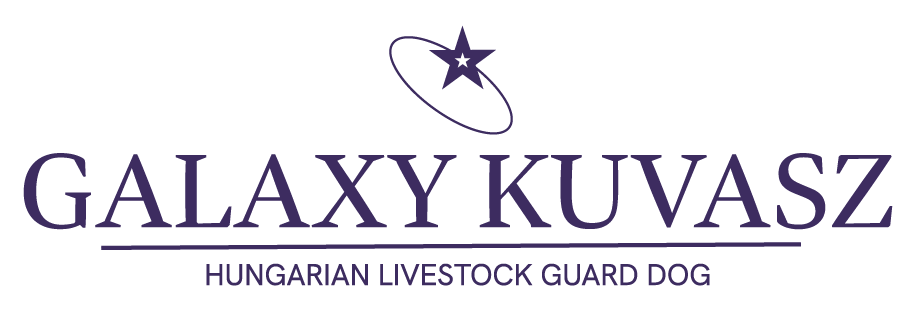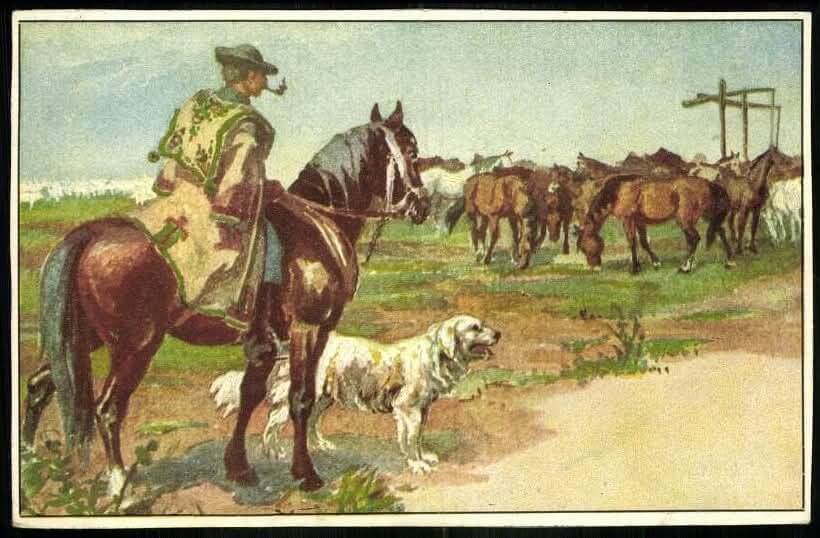A Bit of History
The Kuvasz is a breed with an ancient history, though its exact origins are still debated by scholars. Its story begins with nomadic tribes from Asia, the Middle East, and Europe who settled in the Carpathian Basin. These early tribes had no written histories, leaving the breed’s beginnings open to interpretation.
As the region grew into an agricultural center, Hungarians developed unique breeds of dogs and livestock. By the Renaissance, the Kuvasz gained prominence under King Matthias of Hungary, who kept them as guardians of his properties in Hungary and Transylvania. Evidence of the breed during this period includes a Kuvasz skull discovered in a grave.
Under Ottoman rule, Kuvaszok were depicted in art as shepherds’ companions, helping to drive Hungarian gray cattle to German and Austrian markets before the railroads. The breed’s white coat was favored for its practical role in distinguishing them from wolves or thieves.

Kuvasz in Modern History
In the 1860s, Kuvasz were exhibited in Vienna and Hungary. Interest in national breeds of Hungary were increasing in popularity. Descriptions of kuvasz were also discussed in the press. World War I limited the breeding. The peace treaty resolving the war forced Hungary to give up Transylvania area, which split the breeding stock across borders. After importing dogs across these borders was resolved, a refined standard was published in 1914 and further revised in 1921 by Emil Rabitsits. This published standard helped increase the population of kuvaszok in many countries.
Just prior to World War II, the Abonyi-Anghi-Marki breed standard was written in 1935. Mr. Abonyi was the president of the Hungarian Kennel Club and Director of the Budapest Zoo. Mr. Angyi was the managing director of the Budapest Zoo. Dr. Marki was a veterinarian. The important updates were the elimination of the cords for the coat and the elimination of any color but white. This revision separated the Komondor from the Kuvasz.
Due to two World Wars and separation of the traditional Hungarian territory, the Hungarian population of kuvasz declined. The economy was poor. Soldiers ransacking farms or other property for provisions killed many brave and loyal dogs. Farms were being industrialized and excess labor was forced into the cities for factory work. Kuvasz did not have a place in this society. Many Hungarians left the country to seek better lives or avoid the harsh restrictions of the government.
Meanwhile in the USA, a Hungarian couple came to the USA for better life bringing a pair of Kuvasz. This couple placed these dogs with Miss Mabel Marsh. Miss Marsh registered one of these dogs with the AKC and he entered the AKC Studbook in 1928. She became the first kuvasz breeder in the USA under the kennel name, Romance. Mabel Marsh became Mrs. J Scoffield Rowe. She imported another female prior to World War II. She exhibited her dogs in the thirties at Morris and Essex dog shows. Thru her efforts, kuvasz began to gain acceptance and in the late thirties a Kuvasz Club was created. In the forties, Romance Kennel became inactive after the death of Mr. Rowe and Mrs. Rowe died in 1956. Sadly none of the Romance lines exist today.

Several USA kennels began breeding following World War II. In 1946, Mr. and Mrs. Frank Ziegler imported Dickens Von Leonardshof from Germany. Her purchase price was food packages. Frank Ziegler bred her to their 1947 import, Rike von Waldfrid and they had 10 puppies. These dogs were also exhibited in Morris and Essex dog shows. Due to advanced age, they became inactive in the fifties.
In the late fifties and sixties, the kuvasz began a revival in Canada and the USA. One pair of dogs from Zieglers’ litter began Wish-A-Way kennels. Dorothy and Tom Grosart formed Tall Grass Kennel in Canada in 1962. In Detroit, they met a man of Hungarian decent and arranged to get a pair of kuvasz in exchange for a pair of Canadian Geese for the Budapest Zoo. Tall Grass kennels also imported several other kuvasz. Tall Grass kennels and Wish-A-Way kennels used sire, Condor Oznerol from Ziegler. This dog is the only USA bred dog in today’s USA bloodlines.
In Hungary, Mr. Anghi wanted to develop a method to preserve the kuvasz. The group worked to get government support to save the national heritage breed. Under the leadership of Antal Kovacs Sr., Gyapjus kennel was established in 1953. This kennel searched the countryside for remaining dogs to restart kuvasz in Hungary. They were able to build the numbers and many of these dogs were imported to worldwide.
The late sixties and seventies, many countries had hobby kennels. The population of Kuvasz had healthy increases. In the USA and Canada, the population was at its peak in the late eighties. From mid nineties to today, the worldwide population for Kuvasz has been decreasing. My hope is my passion for Hungarian Kuvasz is ignited in you.


